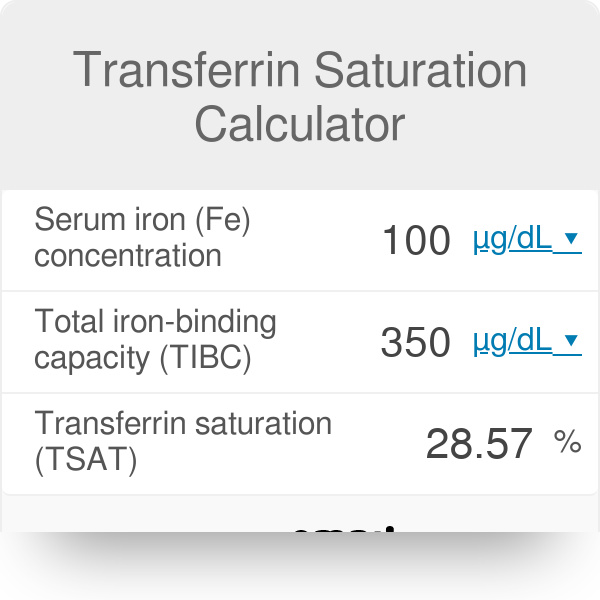When understanding your body’s health, certain measurements and tests can provide valuable insights. One such test is the calculation of Transferrin Saturation (TSAT), which is an important indicator of iron status in your blood. It helps in diagnosing and managing conditions like anemia or iron overload disorders. Calculating TSAT is a straightforward process that involves a simple formula, but it relies on accurate input from blood test results. This guide will walk you through a step-by-step approach to understand TSAT and its implications on your well-being, equipping you with the knowledge to discuss your health more informatively with healthcare professionals.

Understanding Blood Iron Tests
Before calculating TSAT, it’s important to understand the role of the various iron tests and how they can indicate different aspects of your iron metabolism. Iron tests typically include measurements of serum iron, total iron-binding capacity (TIBC), and sometimes ferritin levels. TSAT is a calculation based on serum iron and TIBC levels, offering a view of how saturated transferrin proteins are with iron.
Detailed Steps:
-
Get your blood test results: Begin with obtaining the necessary blood test results from your healthcare provider. You’ll need the serum iron and TIBC levels, usually measured in micrograms per deciliter (mcg/dL).
-
Understand serum iron: Serum iron is the amount of iron currently in your bloodstream. Higher or lower levels can indicate various conditions.
-
Grasp TIBC: TIBC measures all proteins available to bind with iron, which includes transferrin. This tells you the maximum amount of iron that can be carried through the blood.
-
Calculate TSAT: Take your serum iron level and divide it by your TIBC level. Then, multiply the result by 100 to get the TSAT percentage.
Summary:
Calculating TSAT provides a percentage that shows how much of the iron-binding sites on transferrin are occupied. This is beneficial as it contributes to a better understanding of iron status beyond the basic serum iron level. However, interpreting the results can sometimes be complex and should ideally be done in conjunction with other tests such as ferritin levels for an accurate assessment.
Identifying Symptoms of Iron Imbalance
Recognizing the symptoms associated with iron imbalance can prompt timely calculation and interpretation of TSAT. Symptoms of iron deficiency or overload may include fatigue, weakness, pale skin, or joint pain. Being aware of these can help in understanding the need for evaluation and the relevance of TSAT.
Detailed Steps:
-
Monitor symptoms: Keep a diary to note down any persistent symptoms that could be related to iron levels.
-
Communicate with your healthcare provider: Share these observations with your doctor; they can advise if a TSAT calculation is necessary.
-
Follow-up with blood tests: If your doctor recommends it, get the required blood tests done to assess your iron status.
Summary:
Identifying symptoms can be beneficial in determining whether a TSAT calculation is necessary and understanding its implications. Being proactive in symptom monitoring and communication with your doctor enhances individual healthcare management. However, self-diagnosis should be avoided as symptoms can be common to many conditions.
Understanding Dietary Influence on Iron Levels
Diet plays a significant role in managing your iron levels. Certain foods and beverages can either help increase or decrease iron absorption in your body, which in turn affects TSAT values. Becoming aware of these can aid in effectively managing your iron status.
Detailed Steps:
-
Learn about iron-rich foods: Incorporate more red meat, beans, lentils, fortified cereals, and leafy greens into your diet to help increase iron levels.
-
Consider inhibitors and enhancers of iron absorption: For example, vitamin C can enhance iron absorption, while calcium can inhibit it.
-
Discuss dietary changes with a healthcare provider or dietitian: Ensure that any dietary modifications will benefit your specific health needs.
Summary:
Understanding the dietary influence on iron levels and thus TSAT is invaluable for anyone managing iron-related health conditions. Tailoring your diet can be beneficial in maintaining optimal iron status. However, dietary changes should be personalized and professionally advised to prevent further imbalances.
Incorporating Lifestyle Modifications
Lifestyle factors can significantly impact iron levels and your overall health. Incorporating positive changes can improve iron status and TSAT values.
Detailed Steps:
-
Adopt healthy habits: Regular physical activity and avoiding excessive alcohol can positively influence iron levels.
-
Manage medication intake: Some medications can affect iron absorption; consult with your healthcare provider about the possible impacts of your current medication.
-
Prioritize sleep and stress management: Adequate sleep and stress reduction can help regulate iron metabolism.
Summary:
Lifestyle modifications offer a holistic approach to managing TSAT and iron levels. While beneficial in promoting general health, it’s important to apply changes gradually and with professional guidance to ensure they are suitable for your personal health circumstances.
Understanding the Role of Transferrin in Iron Transport
Transferrin is the main protein in the blood that binds to iron and transports it throughout the body. Understanding its function is key to interpreting TSAT correctly.
Detailed Steps:
-
Educate yourself about transferrin: Learn how it functions in iron transport and its significance in your body.
-
Recognize normal transferrin levels: These can vary depending on age and sex, but are usually well established in lab reports.
-
Consider how medical conditions can affect transferrin: Certain illnesses can alter transferrin production and function.
Summary:
Comprehension of transferrin’s role in iron transport enhances the understanding of TSAT results. This understanding is important for grasping the broader picture of iron metabolism, although it must be remembered that transferrin levels alone are not the sole indicator of iron status.
Utilizing TSAT in Chronic Disease Management
TSAT calculation is particularly valuable in the management of chronic diseases such as chronic kidney disease (CKD) or liver disorders, where iron metabolism can be significantly affected.
Detailed Steps:
-
Acknowledge the role of TSAT in chronic diseases: Understand that managing TSAT is often a component of treatment for certain chronic conditions.
-
Track TSAT over time: Regular monitoring can help in adjusting treatments and managing disease progression.
-
Coordinate with healthcare providers: Ensuring that TSAT is integrated into your overall care plan is crucial for optimal management.
Summary:
TSAT calculation plays a crucial role in chronic disease management by helping to adjust treatments and track disease progression. It requires regular monitoring and coordination with healthcare professionals to ensure that it’s effectively contributing to the overall care strategy.
Tips for Accurate Blood Sampling
Accurate blood sampling is the cornerstone for reliable TSAT calculation, as any errors can lead to incorrect results.
Detailed Steps:
-
Follow fasting instructions: Fasting before a sample is often required for accurate serum iron measurements.
-
Understand the timing of sampling: Iron levels fluctuate throughout the day, and your healthcare provider can advise on the optimal time for testing.
-
Ensure proper sample handling: Discuss with the lab or healthcare provider about the procedure to ensure the sample is handled correctly.
Summary:
Accurate blood sampling leads to reliable TSAT calculations, which in turn informs better health management. Fasting and timing are essential factors, alongside correct handling procedures. Missteps in this process could alter results, so adherence to pre-test instructions is crucial.
Interpreting TSAT Results with Other Iron Markers
TSAT should be interpreted in conjunction with other iron markers like serum ferritin and serum iron to get a comprehensive understanding of iron status.
Detailed Steps:
-
Compare TSAT with serum ferritin: Serum ferritin reflects stored iron, and comparing it with TSAT can provide a fuller iron status picture.
-
Analyze alongside serum iron: This helps to understand if there is a balance between circulating and stored iron.
-
Consider the complete blood count (CBC): A CBC can also assist in evaluating overall blood health and may indicate anemia or other conditions.
Summary:
Interpreting TSAT alongside other iron markers provides a comprehensive view of one’s iron status, which is critical in diagnosing and managing iron-related conditions. While a valuable tool, it requires a healthcare professional’s expertise to interpret correctly, and analyzing it in isolation is not recommended.
Understanding TSAT in Different Populations
Age, sex, and specific life stages, such as pregnancy, can influence TSAT levels. Recognizing these variances is essential for accurate interpretation.
Detailed Steps:
-
Consider demographic factors: Be aware that TSAT norms can differ between children, adults, men, and women.
-
Account for life stages: Pregnancy and menstruation can significantly impact iron levels and should be considered when interpreting TSAT.
-
Discuss these factors with a healthcare provider: They can provide context-specific reference ranges and interpret TSAT accordingly.
Summary:
TSAT norms can vary depending on demographic and life stage factors, making it crucial to contextualize results. Being aware of these differences benefits individualized healthcare, but it also requires professional interpretation to avoid misdiagnosis.
Conclusion
Understanding Transferrin Saturation is an empowering step towards taking control of your iron health. This guide aimed to demystify the TSAT calculation process and provide valuable insights into maintaining balanced iron levels. With a backbone of knowledge and the support of healthcare professionals, you’re better equipped to interpret your results and participate actively in your health journey.
Frequently Asked Questions
Q: Why is calculating TSAT important?
A: Calculating TSAT is important because it helps determine how much iron is being transported in the blood and allows healthcare providers to assess iron status more accurately, aiding in diagnosing and managing iron-related conditions.
Q: Can I calculate TSAT at home?
A: While you can do the actual calculation at home if you have the serum iron and TIBC values from a blood test, it is essential that the blood test itself is done professionally in a healthcare setting to ensure accuracy.
Q: How often should TSAT be calculated?
A: The frequency of TSAT calculation should be guided by a healthcare professional and depends on individual conditions and treatment plans. It is often part of routine check-ups for patients managing chronic conditions related to iron metabolism.








